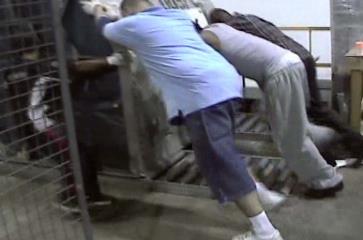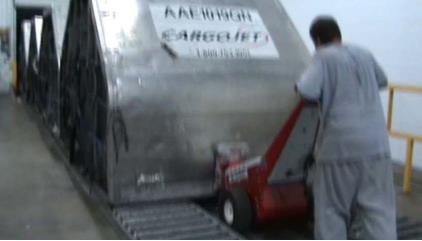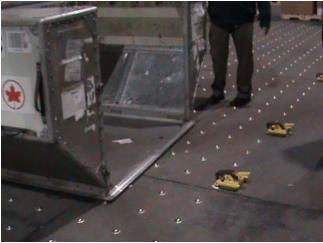Moving Freight Pallets (Air Cans)
Description of the Case
Concern Details
Task Description
Packages that are transported by airplanes are first loaded into air cans. The air cans have to be moved from the courier depot to the airplanes at the airport. The air cans are very heavy when full and require excessive force to move them even if they are on rollers. It takes 4-7 workers working together to manually move the air cans on the rollers.

Evaluation
Moving air cans into trailers requires an excessively high push which was not possible to quantify the force of because it exceeded the maximum threshold of the force gauge (113 kg). The required force exceeds the strength capabilities of males and females1 as well as the maximum acceptable push force of 27 kg.2 In addition, based on the analysis with a biomechanical human model (3D SPSS), the majority of the population does not have appropriate strength to push the air cans. Manually pushing the air cans results in increased risk of injury. Furthermore, tripping hazards are also cause for concern when the workers push the air cans over the rollers.
Controls
The following countermeasures are recommended to reduce the risk of injury to the workforce when moving the air cans:
Implement power pusher.
- Power pushers can eliminate the risk of manually pushing the air cans. It may also be necessary to add emery/friction tape to the floor to improve traction.

Install roller ball floors.
- Roller ball floors can be used to move the air cans.

References or resources
The information contained in this document was developed in partnership with the Infrastructure Health and Safety Association (https://www.ihsa.ca/topics_hazards/msds.aspx) and CRE-MSD as part of the following project funded by the Workplace Safety and Insurance Board (Ontario):
Kramer, D., Bigelow, P., Vi, P., Garritano, E., Wells, R. Encouraging construction companies to adopt innovations to reduce MSDs using different knowledge transfer techniques. 2008-2011.
